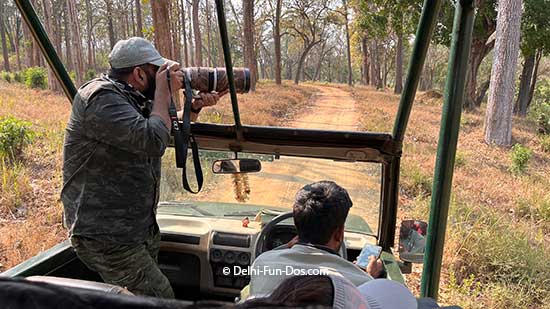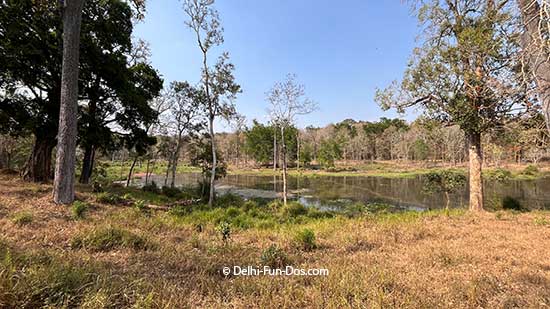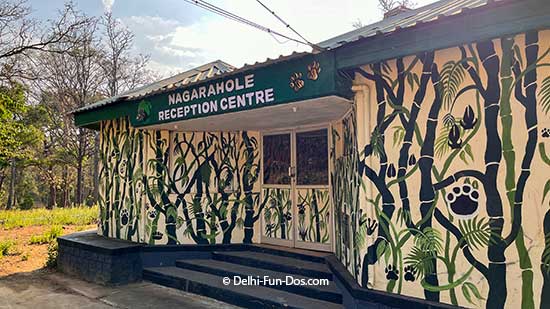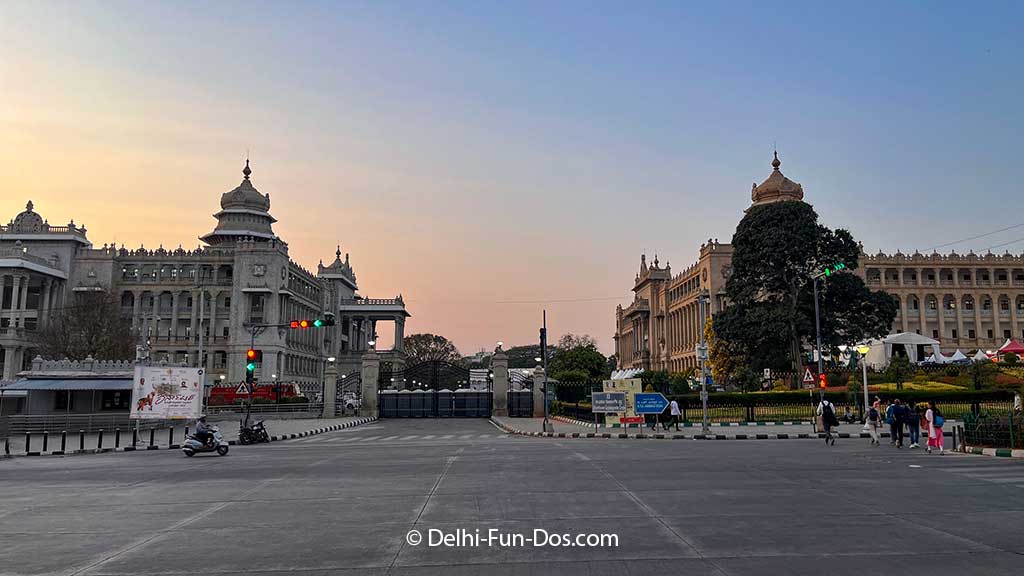From Jim Corbett to Sariska and from Ranthambore to Bharatpur – we’ve done a lot of safaris, but we had never seen a tiger. We became one of those people who say, “Tigers aren’t everything, you get to see many other animals on a safari, and that’s fine. We go to enjoy the forest; the tiger is just a bonus.”
But then, on our very recent trip to Coorg, the narrative changed forever.
Contents
Nagarhole Tiger Safari: Our Once-in-a-Lifetime Wildlife Experience in Coorg

People visit Coorg for its natural beauty, its romantic weather, and its flowers and trees. But if you’re a wildlife enthusiast or a nature lover, Nagarhole Tiger Reserve in Coorg, Karnataka, should be on your bucket list. In fact, the jungle safari in South India was new to us. Our recent safari to this enchanting forest finally ended our years-long wait to spot a tiger in the wild. Here’s a detailed account of our thrilling experience and all the practical details you need to plan your own Nagarhole jungle safari.
From Corbett to Coorg: The Long Wait for a Tiger Sighting
At the beginning of a safari, the guide would say, “Tigers aren’t everything—safaris offer much more.” We acknowledged the philosophy in the statement.

Yet, deep down, we longed for that moment when the forest would bless us with a tiger sighting. And that moment finally came—unexpectedly-in the lush, misty forests of Coorg.
The Magical Safari at Nagarhole Tiger Reserve
On our recent trip to Coorg, we decided to go for our first South Indian tiger safari at Nagarhole National Park, also known as Rajiv Gandhi National Park. We thought it would be another peaceful ride through the jungle. We had seen the spotted deer, the antlers, peacock, and many cute herds of elephants with the little calves frisking in the centre of the group, guarded by the adults. But it was afternoon, and the scorching heat was depleting. Mild disappointment to boredom was evident on the faces of all 8 of us in the safari Jeep.

Suddenly, we saw 2-3 safari jeeps stopped ahead. There was a wave, and the driver of the opposite jeep silently pointed to his left. And there it was – a tiger resting in the wild, just a few metres away from our jeep. The incredibility of the situation rendered us numb, and it took us a few moments to locate the majestic beauty, even when he was so close. We could not believe that those bright yellow and white stripes lazily licking its paws was the real big cat.
Holding our breath, we captured dozens of photos, amazed and speechless. The persona of the moment moved his head left and right, licked his whiskers, yawned, and stretched. That afternoon sun gave him and his surroundings a golden halo. Just when we thought the moment was over, the tiger stood up. Completely ignoring all the fandom in the vehicles on both sides, he walked across the road, right in front of us. The confident, relaxed gait is way beyond the most stylish walks we have seen on the ramp. We now realised the import of the term “cat walk”.

According to our naturalist, Mr Tiger was preparing for a hunt. A herd of bison, unaware of the danger, grazed in the marsh on the other side. The tiger silently moved past us and entered the marshland amidst the tall green-brown tiger grass, its eyes fixed on its prey.
We lost him for a while since he was moving very slowly. But his head suddenly appeared as he stealthily moved from one bush to another, its eyes resting on the nearest bison. For the first time, we understood the import of the word “stealth”. The herd of bison were completely oblivious to his presence, and there was no alert calls associated with the presence of a big predator. After a rather long time, one in the herd might have suspected something. He steadfastly stared in the direction of the tiger for quite some time.
We watched this mesmerising scene unfold for nearly an hour, but could not see the climax. Our guide mentioned the hunt could take more than two hours, and it was already around 6:30 – beyond that, we couldn’t stay in the forest. So we had to leave this thriller incomplete. But we had no regrets.
Finally, the curse of not seeing a tiger broke, and we got to observe the spectacle for almost an hour!
The Perfect Homestay near Nagarhole Safari

We stayed at Coorg Wild Walk, a beautiful homestay by CGH Earth, just 10 minutes away from the Nagarhole Safari Gate. They share their boundary with the forest. After returning, we enjoyed a hot cup of tea and more thrilling tiger tales shared by the naturalist and manager. The entire day felt surreal—like a scene out of a nature documentary.
How to Reach Nagarhole Tiger Reserve
The nearest towns to the Nagarhole Safari are Kutta Gate (Southern Entrance), which is best for visitors coming from Coorg, or Veeranahosahalli Gate (Northern Entrance), better suited for those coming from Mysore
- By Air: The nearest airport is Kannur International Airport (90 km). You can also consider Mysore Airport (96 km).
- By Train: The closest railway station is Mysore Junction, about 90 km from the park.
- By Road: Nagarhole is well-connected by road. You can hire a cab or take a bus from Mysore, Coorg (Madikeri), or Bangalore (220 km).
How to Book Nagarhole Safari Tickets

- Online Booking: You can book your safari online through the official Karnataka Forest Department website.
- Offline Booking: Tickets can also be booked at the entry gates (Kutta or Veeranahosahalli). However, given the high demand, advance booking is recommended, especially during weekends and holidays.
- Safari Type: Choose between Jeep Safari and Canter Safari (shared bus). Jeep safaris, although more expensive, are more personalised and suitable for photography enthusiasts.
Depending on whether you are on a jeep or a canter, you may be charting separate routes. It is said that jeeps can penetrate deeper areas of the forest than canter since jeeps are smaller vehicles.
Nagarhole Safari Timings
Only certain zones of the forest are open for visitors at fixed hours, and that too on designated routes. Safaris operate at designated timings:
- Morning Safari: 6:00 AM to 8:00 AM / 8:00 AM to 10:00 AM
- Evening Safari: 3:00 PM to 5:00 PM / 4:00 PM to 6:00 PM
The timings may vary depending on the season and weather conditions.

We are told morning safaris are more conducive for tiger sighting since tigers are prowlers and they are out for a hunt at night till early morning when it is cold. They tend to rest during the day when the sun is up. Yet, as luck would have it, all our tiger sightings are afternoon safari stories – so much for theory. We imagine there must be that occasional tiger dude who is a bit laidback and likes a late lunch.
Best Time to Visit Nagarhole National Park

Nagarhole is located in the Western Ghats. Bordered by Coorg in Karnataka and Wayanad in Kerala, Nagarhole is pleasant most times of the year.
- October to May is considered the best time to visit, especially March to May. We are told that the chances of tiger sightings increase due to dry weather and scarce water sources.
- Avoid monsoon months (June to September), as the park may remain closed and wildlife movement reduces due to thick foliage and rains.
Why Nagarhole Should Be on Every Wildlife Lover’s List
Nagarhole National Park in the Western Ghat Mountains is traversed by two main rivers: the Nagarhole River and the Kabini River. The forest here is a picturesque landscape replete with lush haven of teak and sandalwood trees, shimmering streams, and rich wildlife. Its serene beauty enhances the thrill of spotting various birds and animals in their natural habitat. It offers a rare blend of peace and adventure for every nature and wildlife enthusiast.
Unlike some commercialised reserves, Nagarhole offers a serene, less crowded, and authentic safari experience. The park is home to tigers, leopards, elephants, Indian bison (gaur), spotted deer, barasingha deer, wild dogs, and a wide variety of birds.

Our long-awaited tiger sighting made it a trip of a lifetime. The heady feeling of watching a tiger walk by in its natural habitat is something we’ll never forget—and Nagarhole made that dream come true.
Dos and Don’ts of Nagarhole safari
Jungle safaris are a common mode or exploring wildlife. While we love the beauty of the forests, each jungle be in the Northern Himalayas, the Eastern Himalayas, or the Western Ghats is unique with easily distinguishable flora and fauna. Tiger of no tiger, a jungle safari is an eye-opening experience of the magic of Mother Nature.

Yet, at some level, we need to pause. We penetrate the natural habitats of many creatures in a safari, big and small. We disturb their peace, routine, and daily life. And sometimes humans behave irresponsibly, from littering the forest to even petting tigers. Apparently, there was no tiger sighting during the safaris in the week following our safari, and this could disappoint tourists. Therefore, such safaris are a risk to wildlife as well as humans and raise deeply ethical questions.
We were made to follow some rules during our safari at Nagarhole, and thankfully our co-travellers, including a little child, were lit souls who were all compliant.
- Once the safari started, we were allowed to disembark only once at a designated spot that had restrooms for visitors.
- We were not allowed to carry plastic bottles or food bags.
- Our guide was very cautious and repeatedly reminded us that we should not throw or discard any object outside the jeep. Litter, if any, would have to be kept inside the jeep.
- Everyone kept their voices down to not disturb the forest life.
Following the above simple rules indeed helped to enjoy the forest and its offerings better.
Is Nagarhole safari worth?
If you’re looking to combine wildlife, peace, and the lush greenery of the Western Ghats, Nagarhole Tiger Safari in Coorg is the perfect choice. The reddish brown soil punctuated with greenery and crisscrossed with streams is indeed succour for city-weary eyes. Book your safari in advance, choose a nature-friendly stay, and let the forest surprise you, as it did us.




0 Comments